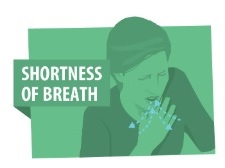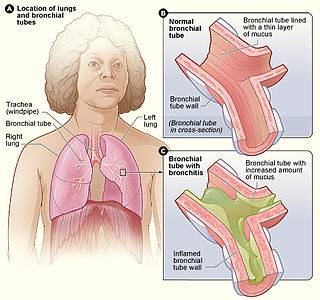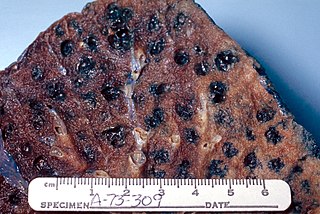
A respiratory therapist is a specialized healthcare practitioner trained in critical care and cardio-pulmonary medicine in order to work therapeutically with people suffering from acute critical conditions, cardiac and pulmonary disease. Respiratory therapists graduate from a college or university with a degree in respiratory therapy and have passed a national board certifying examination. The NBRC is the not-for-profit organization responsible for credentialing the seven areas of Respiratory Therapy in the United States.

Respiratory failure results from inadequate gas exchange by the respiratory system, meaning that the arterial oxygen, carbon dioxide or both cannot be kept at normal levels. A drop in the oxygen carried in blood is known as hypoxemia; a rise in arterial carbon dioxide levels is called hypercapnia. Respiratory failure is classified as either Type 1 or Type 2, based on whether there is a high carbon dioxide level, and can be either acute or chronic. The definition of respiratory failure in clinical trials usually includes increased respiratory rate, abnormal blood gases, and evidence of increased work of breathing. Respiratory failure causes an altered mental status due to ischemia in the brain.

Shortness of breath (SOB), also known as dyspnea is a feeling of not being able to breathe well enough. The American Thoracic Society defines it as "a subjective experience of breathing discomfort that consists of qualitatively distinct sensations that vary in intensity", and recommends evaluating dyspnea by assessing the intensity of the distinct sensations, the degree of distress involved, and its burden or impact on activities of daily living. Distinct sensations include effort/work, chest tightness, and air hunger.

Acetylcysteine, also known as N-acetylcysteine (NAC), is a medication that is used to treat paracetamol (acetaminophen) overdose, and to loosen thick mucus in individuals with chronic bronchopulmonary disorders like pneumonia and bronchitis. It can be taken intravenously, by mouth, or inhaled as a mist. Some people use it as a dietary supplement.

Cyanosis is the bluish or purplish discoloration of the skin or mucous membranes due to the tissues near the skin surface having low oxygen saturation. Based on Lundsgaard and Van Slyke's work, it is classically described as occurring if 5.0 g/dL of deoxyhemoglobin or greater is present. This was based on an estimate of capillary saturation based on a mean of arterial versus peripheral venous blood gas measurements. Since estimation of hypoxia is usually now based either on arterial blood gas measurement or pulse oximetry, this is probably an overestimate, with evidence that levels of 2.0 g/dL of deoxyhemoglobin may reliably produce cyanosis. Since, however, the presence of cyanosis is dependent upon there being an absolute quantity of deoxyhemoglobin, the bluish color is more readily apparent in those with high hemoglobin counts than it is with those with anemia. Also, the bluer the color, the more difficult it is to detect on deeply pigmented skin. When signs of cyanosis first appear, such as on the lips or fingers, intervention should be made within 3–5 minutes because a severe hypoxia or severe circulatory failure may have induced the cyanosis.
A nursing diagnosis may be part of the nursing process and is a clinical judgment about individual, family, or community experiences/responses to actual or potential health problems/life processes. Nursing diagnoses foster the nurse's independent practice compared to dependent interventions driven by physician's orders. Nursing diagnoses are developed based on data obtained during the nursing assessment. An problem-based nursing diagnosis presents a problem response present at time of assessment. Risk diagnoses represent vulnerabilities to potential problems, and health promotion diagnoses identify areas which can be enhanced to improve health. Whereas a medical diagnosis identifies a disorder, a nursing diagnosis identifies the unique ways in which individuals respond to health or life processes or crises. The nursing diagnostic process is unique among others. A nursing diagnosis integrates patient involvement, when possible, throughout the process. NANDA International (NANDA-I) is body of professionals that develops, researches and refines an official taxonomy of nursing diagnosis.
Disease management is defined as "a system of coordinated healthcare interventions and communications for populations with conditions in which patient self-care efforts are significant."

Non-invasive ventilation (NIV) is the use of breathing support administered through a face mask, nasal mask, or a helmet. Air, usually with added oxygen, is given through the mask under positive pressure; generally the amount of pressure is alternated depending on whether someone is breathing in or out. It is termed "non-invasive" because it is delivered with a mask that is tightly fitted to the face or around the head, but without a need for tracheal intubation. While there are similarities with regards to the interface, NIV is not the same as continuous positive airway pressure (CPAP), which applies a single level of positive airway pressure throughout the whole respiratory cycle; CPAP does not deliver ventilation but is occasionally used in conditions also treated with NIV.

A nurse practitioner (NP) is an advanced practice registered nurse and a type of mid-level practitioner. NPs are trained to assess patient needs, order and interpret diagnostic and laboratory tests, diagnose disease, formulate and prescribe treatment plans. NP training covers basic disease prevention, coordination of care, and health promotion, but does not provide the depth of expertise needed to recognize more complex conditions. According to the American Association of Nurse Practitioners, an organization that aggressively lobbies for the expansion of the scope of practice of NPs, NPs are educated at the graduate level to provide "primary, acute, chronic, and specialty care to patients of all ages", depending on their field of practice.
A chronic condition is a human health condition or disease that is persistent or otherwise long-lasting in its effects or a disease that comes with time. The term chronic is often applied when the course of the disease lasts for more than three months. Common chronic diseases include arthritis, asthma, cancer, chronic obstructive pulmonary disease, diabetes, Lyme disease, and some viral diseases such as hepatitis C and acquired immunodeficiency syndrome. An illness which is lifelong because it ends in death is a terminal illness. It is possible and not unexpected for an illness to change in definition from terminal to chronic. Diabetes and HIV for example were once terminal yet are now considered chronic due to the availability of insulin and daily drug treatment for individuals with HIV which allow these individuals to live while managing symptoms.

Bronchitis is inflammation of the bronchi in the lungs that causes coughing. Symptoms include coughing up sputum, wheezing, shortness of breath, and chest pain. Bronchitis can be acute or chronic.
In medicine, describing a disease as acute denotes that it is of short duration and, as a corollary of that, of recent onset. The quantification of how much time constitutes "short" and "recent" varies by disease and by context, but the core denotation of "acute" is always qualitatively in contrast with "chronic", which denotes long-lasting disease. In addition, "acute" also often connotes two other meanings: sudden onset and severity, such as in acute myocardial infarction (AMI), where suddenness and severity are both established aspects of the meaning. It thus often connotes that the condition is fulminant, but not always. The one thing that acute MI and acute rhinitis have in common is that they are not chronic. They can happen again, but they are not the same case ongoing for months or years.

Nursing is a profession within the health care sector focused on the care of individuals, families, and communities so they may attain, maintain, or recover optimal health and quality of life. Nurses may be differentiated from other health care providers by their approach to patient care, training, and scope of practice. Nurses practice in many specialties with differing levels of prescription authority. Many nurses provide care within the ordering scope of physicians, and this traditional role has shaped the public image of nurses as care providers. However, nurse practitioners are permitted by most jurisdictions to practice independently in a variety of settings. Since the postwar period, nurse education has undergone a process of diversification towards advanced and specialized credentials, and many of the traditional regulations and provider roles are changing.
Robert Llewellyn Clancy is an Australian clinical immunologist and a pioneer in the field of mucosal immunology. He is known for his research and development of therapies for chronic obstructive pulmonary disease (COPD), commonly known as emphysema.
Pulmonary rehabilitation, also known as respiratory rehabilitation, is an important part of the management and health maintenance of people with chronic respiratory disease who remain symptomatic or continue to have decreased function despite standard medical treatment. It is a broad therapeutic concept. It is defined by the American Thoracic Society and the European Respiratory Society as an evidence-based, multidisciplinary, and comprehensive intervention for patients with chronic respiratory diseases who are symptomatic and often have decreased daily life activities. In general, pulmonary rehabilitation refers to a series of services that are administered to patients of respiratory disease and their families, typically to attempt to improve the quality of life for the patient. Pulmonary rehabilitation may be carried out in a variety of settings, depending on the patient's needs, and may or may not include pharmacologic intervention.

Chronic obstructive pulmonary disease (COPD) is a type of obstructive lung disease characterized by long-term breathing problems and poor airflow. The main symptoms include shortness of breath and cough with sputum production. COPD is a progressive disease, meaning it typically worsens over time. Eventually, everyday activities such as walking or getting dressed become difficult. Chronic bronchitis, and emphysema are older terms used for different types of COPD. The term "chronic bronchitis" is still used to define a productive cough that is present for at least three months each year for two years. Those with such a cough are at a greater risk of developing COPD. The term "emphysema" is also used for the abnormal presence of air or other gas within tissues.

Chronic pulmonary aspergillosis is a long-term fungal infection caused by members of the genus Aspergillus—most commonly Aspergillusfumigatus. The term describes several disease presentations with considerable overlap, ranging from an aspergilloma—a clump of Aspergillus mold in the lungs—through to a subacute, invasive form known as chronic necrotizing pulmonary aspergillosis which affects people whose immune system is weakened. Many people affected by chronic pulmonary aspergillosis have an underlying lung disease, most commonly tuberculosis, allergic bronchopulmonary aspergillosis, asthma, or lung cancer.
Margaret Ruth McCorkle FAAN, FAPOS is an international leader and award-winning pioneer in oncology nursing. She is currently the Florence Schorske Wald Professor of Nursing at the Yale School of Nursing.

Linda Sarna is an American nursing researcher and academic. She is dean, professor and Lulu Wolf Hassenplug Chair of the UCLA School of Nursing. Sarna was appointed the school's seventh dean Nov. 15, 2016,. after serving as acting dean (2014-2015) and interim dean (2015-2016).

Helga Jónsdóttir is a professor in nursing at the Faculty of Nursing in the School of Health Sciences at the University of Iceland and Academic Chair of Nursing Care for Chronically Ill Adults in a joint position at Landspítali the National University Hospital.












